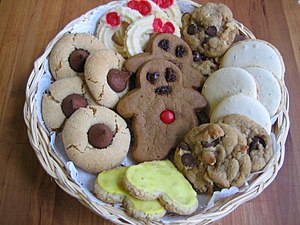 Image via Wikipedia
Image via WikipediaI've been seeing cookie exchanges being mentioned a lot lately. I've been hosting them on and off twenty years now and so I definitely have a set of rules that I think work out really well. Most of the time I've done these at my workplace where you can have as many as 20 people participating. It can get a bit unruly. Sure, there are plenty of ways to host, but this is what works for me.
The Two Basic Rules
1) Your contribution must be homemade, made from scratch. Shortcutting it with brownie mixes or slice and bake cookies just won't cut it in my world.
2) Festive cookies only. Which really means... no chocolate chip, oatmeal, peanut butter, or rice krispie treats allowed. I'm not interested in a cookie that I can get any time of the year at any bake sale or coffee counter. It should be something you only make once or twice a year that is associated with the holidays or special occasions.
How It All Works
I divide people into teams of eight people. That means that each person must make a total of four dozen cookies. You can vary the team sizes, but you want to keep it manageable for the participants. You don't want to ask them to have to bake eight dozen cookies - they wouldn't want to do it!
They make individual gift plates or bags with six cookies in each. They can provide the recipe if they wish, but it is not required. Some people do have their special, family recipes, so I don't push it. I've also asked people who want to to submit their recipes to me a week in advance by email. That way I can put together a little cookie book to give everyone the day of the exchange.
On the day of the exchange, each team swaps plates/bags so that you go home with eight different kinds of cookies. Now this does mean that you have one that is your own submission. Most of the time we take our own plates and donate them for eating there, on the spot. That way people can sample cookies from other teams.
Other Methods
There are other methods of doing cookie exchanges. For instance, everyone brings their plate of cookies and you set them out buffet-like. Each person goes down the line and takes one or two of each cookie. The reason I don't like this style is that people often want to go home with their cookies to share with their families. If there is only one of Sara's Kris Kringle balls, then my spouse/child won't get to try it or there could be fights among siblings.
Cookie exchanges are a lot of fun and the rules can be altered to fit your agenda. With holidays and cookies paired together, you can't help but be in a festive mood.






 Bananas
Bananas










































